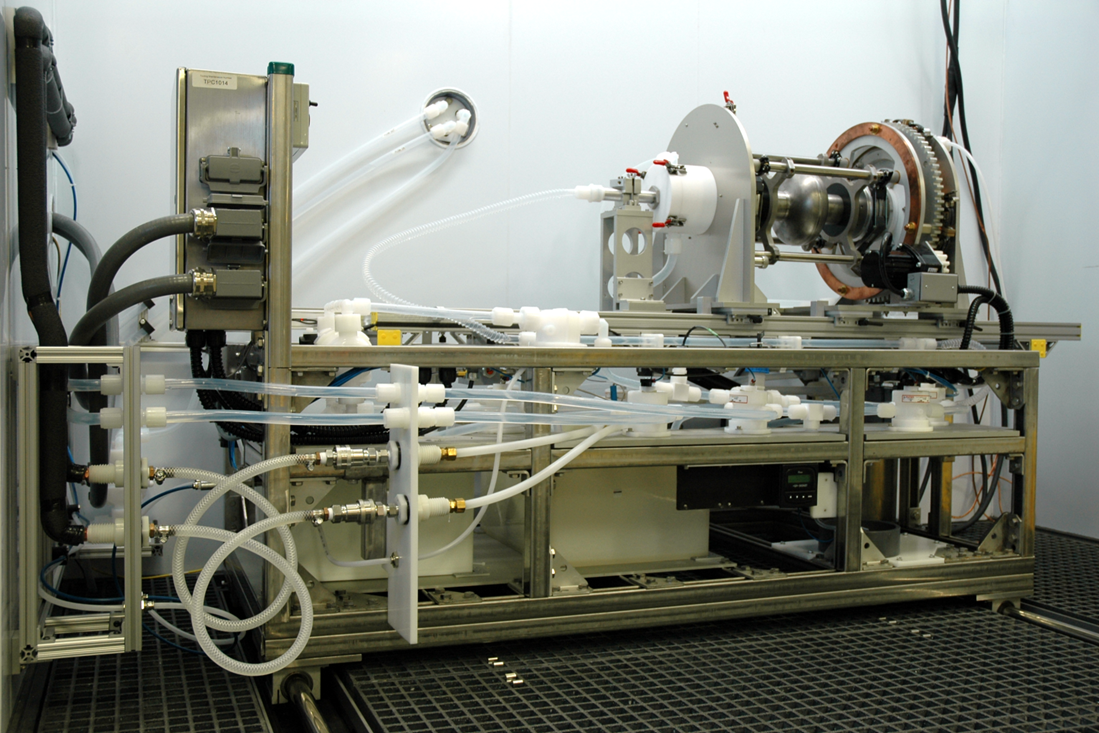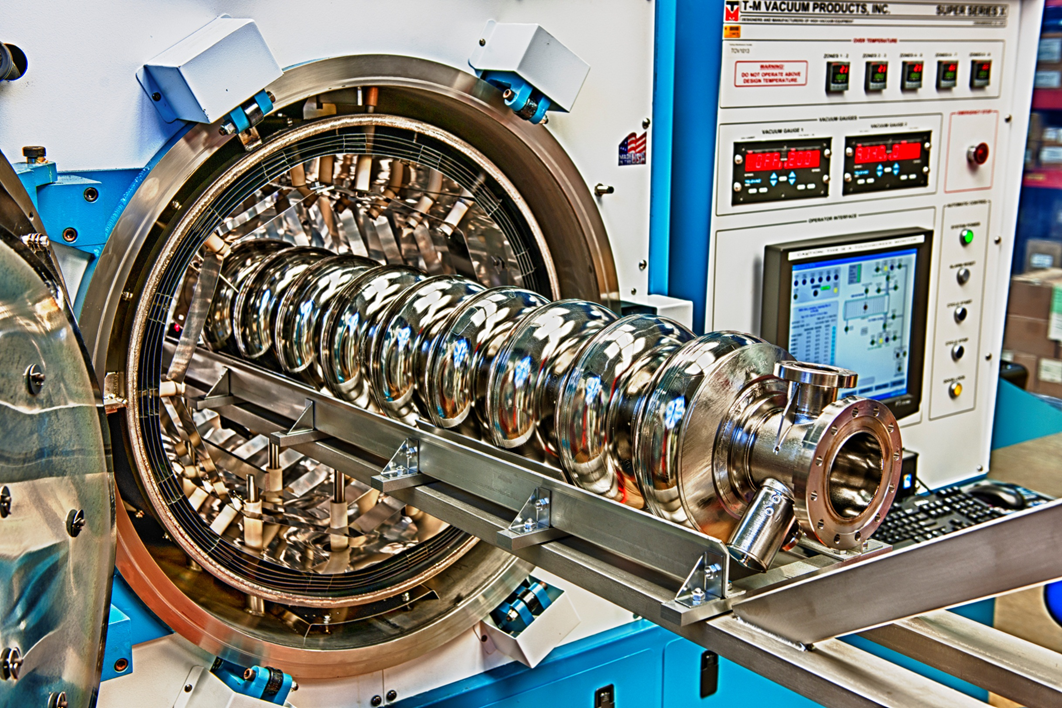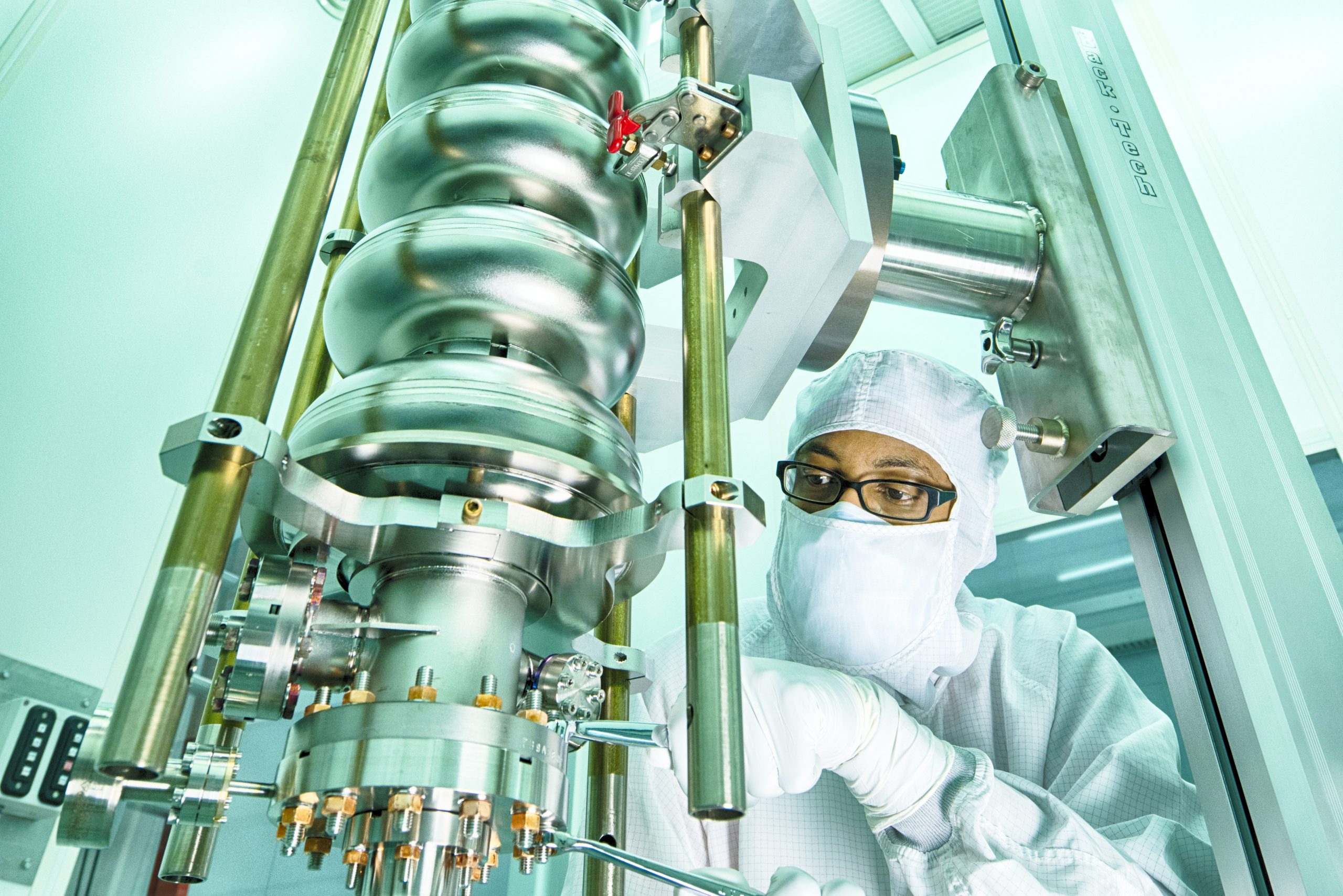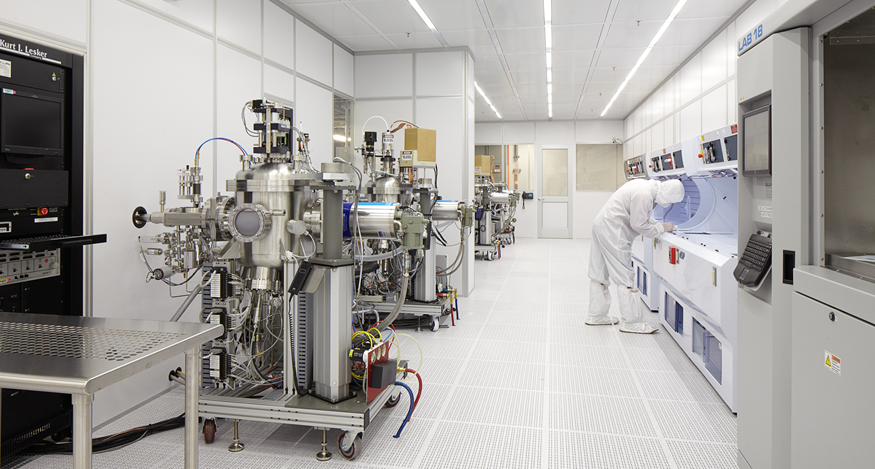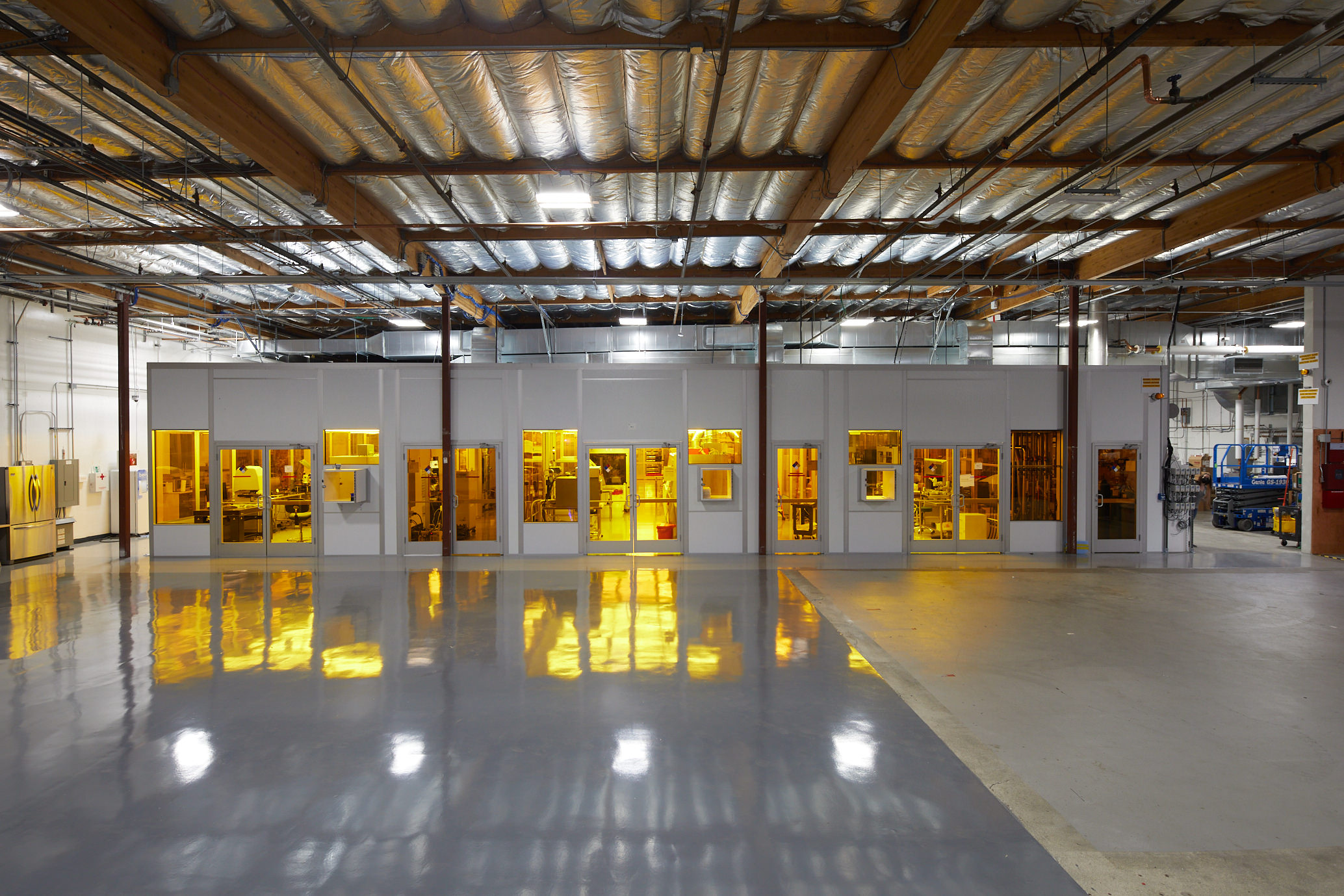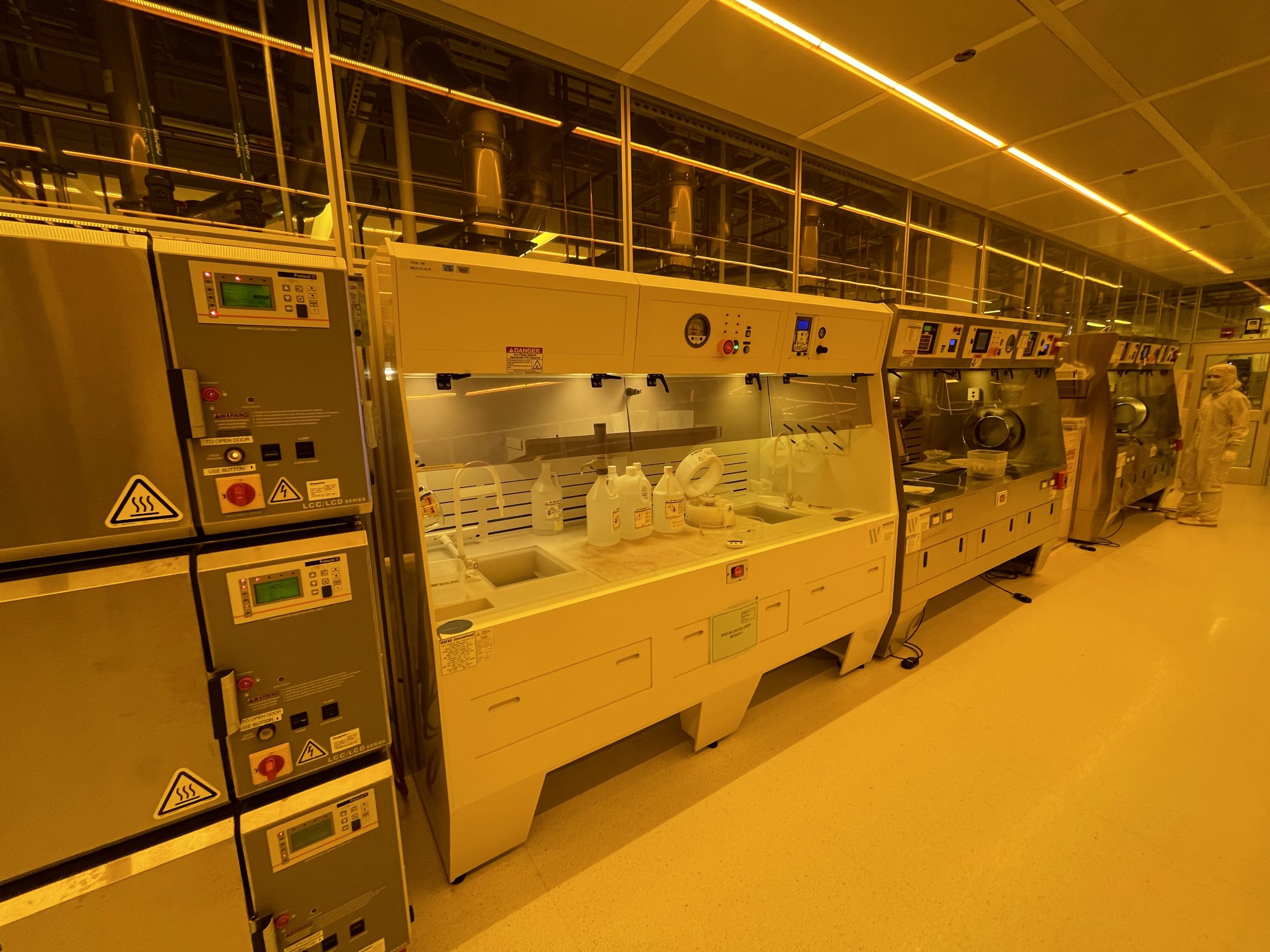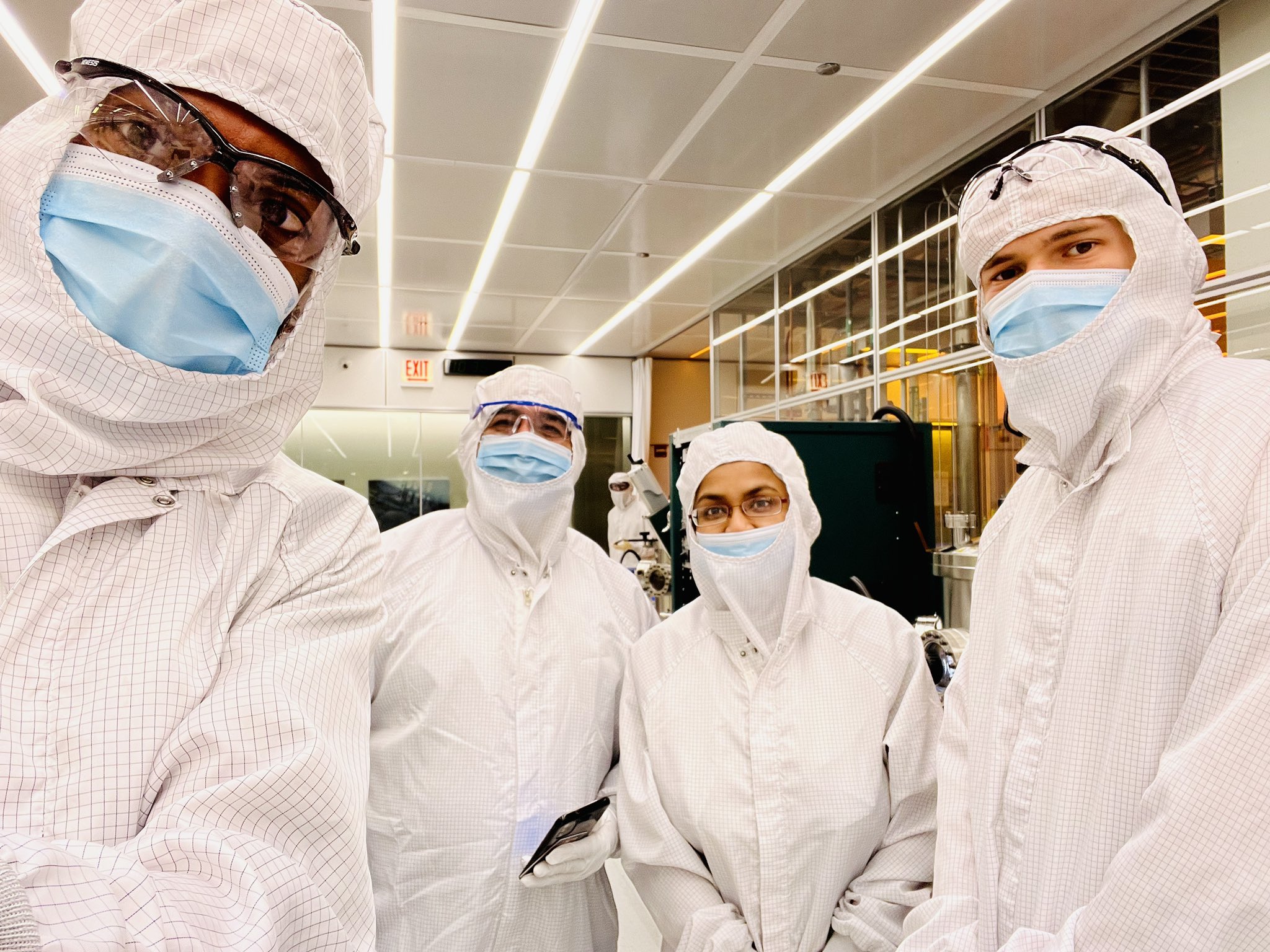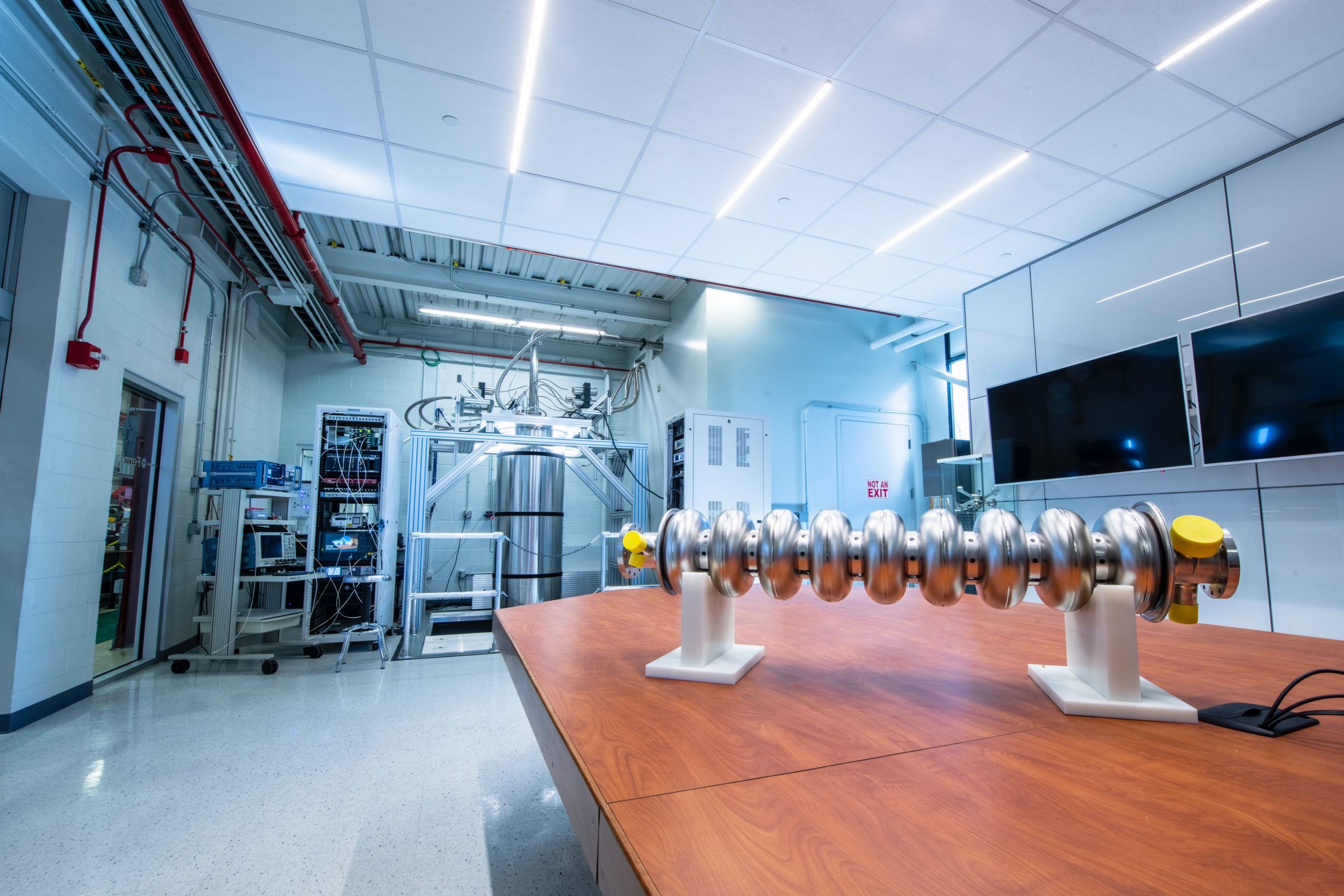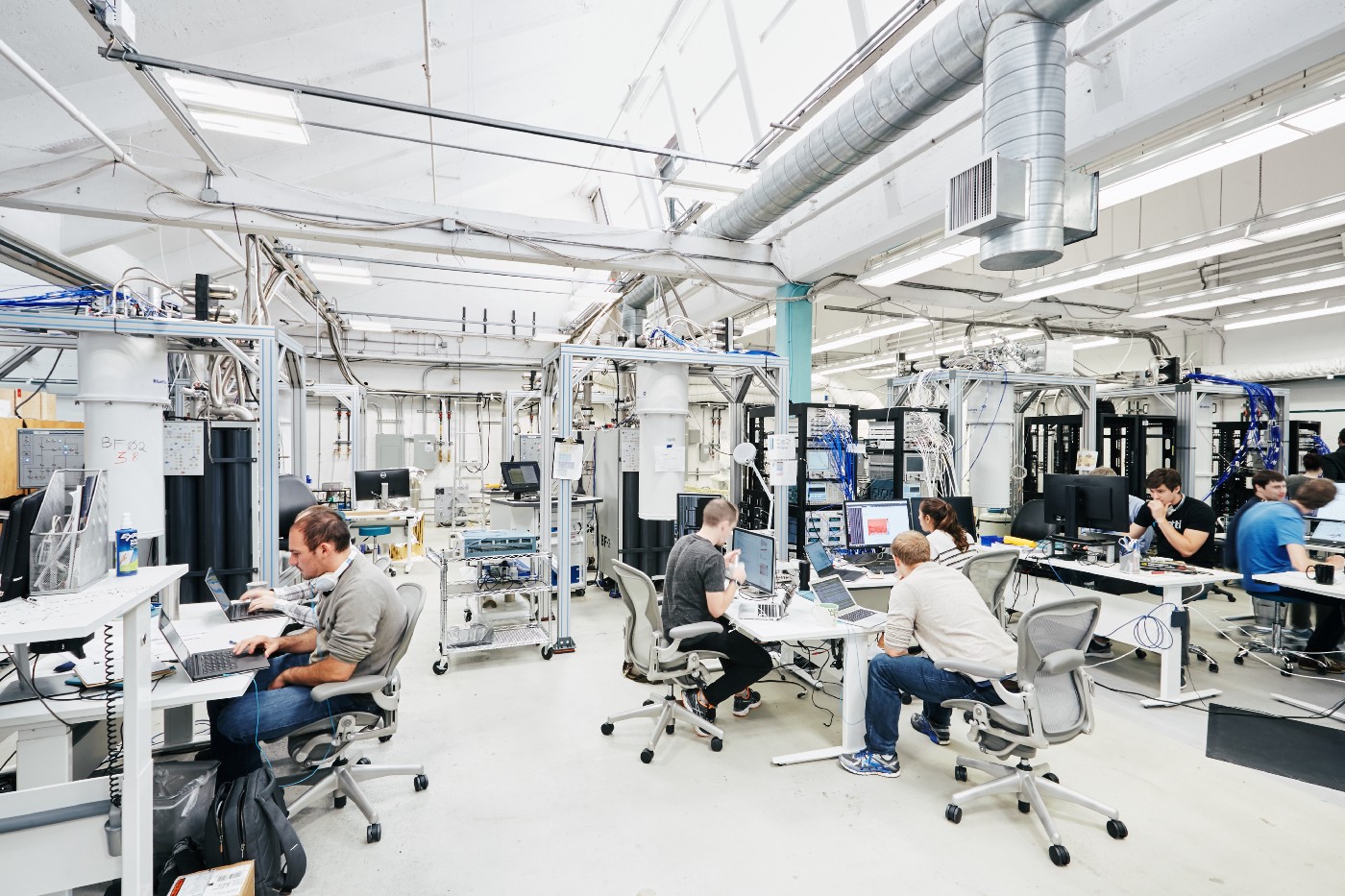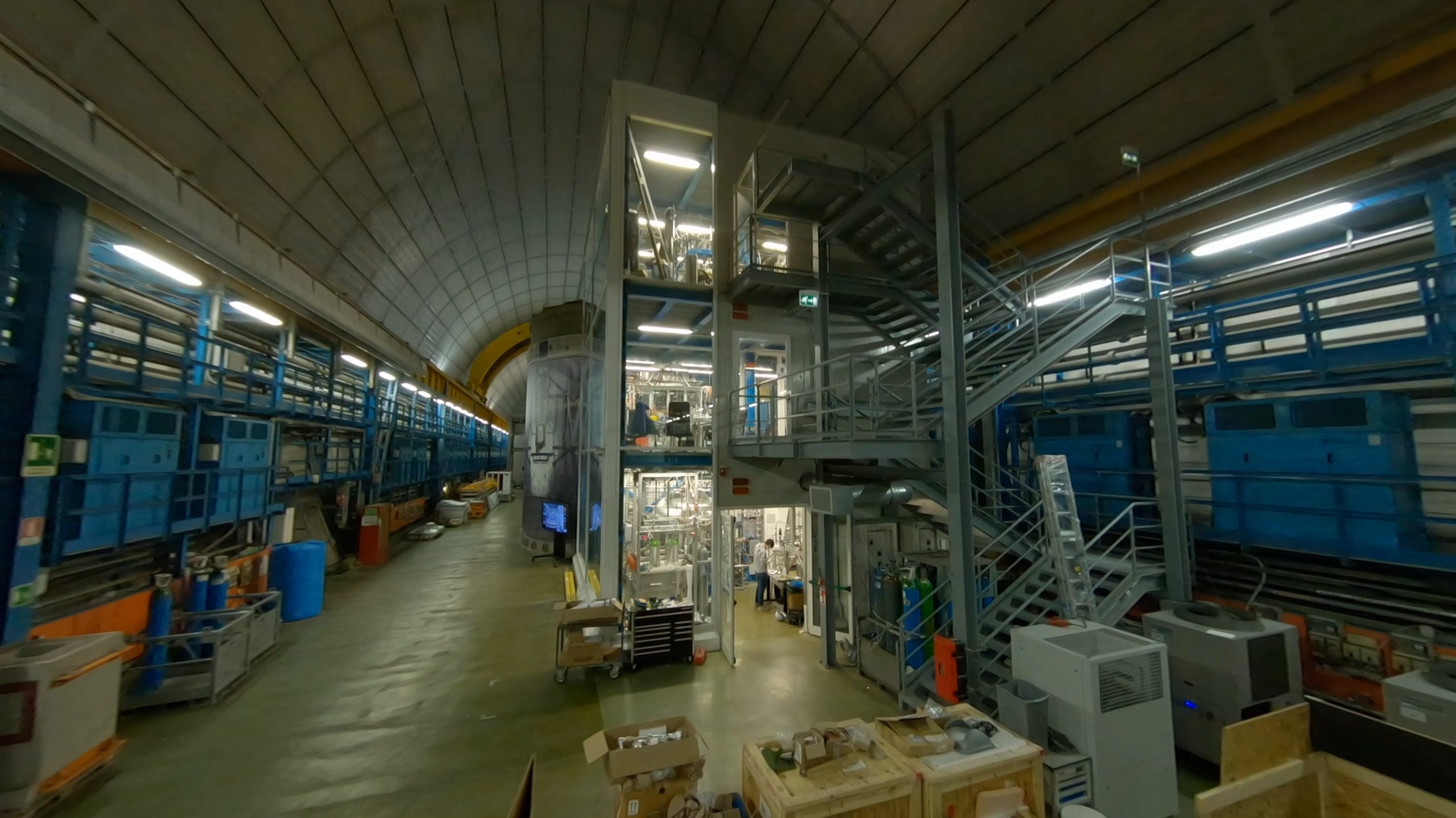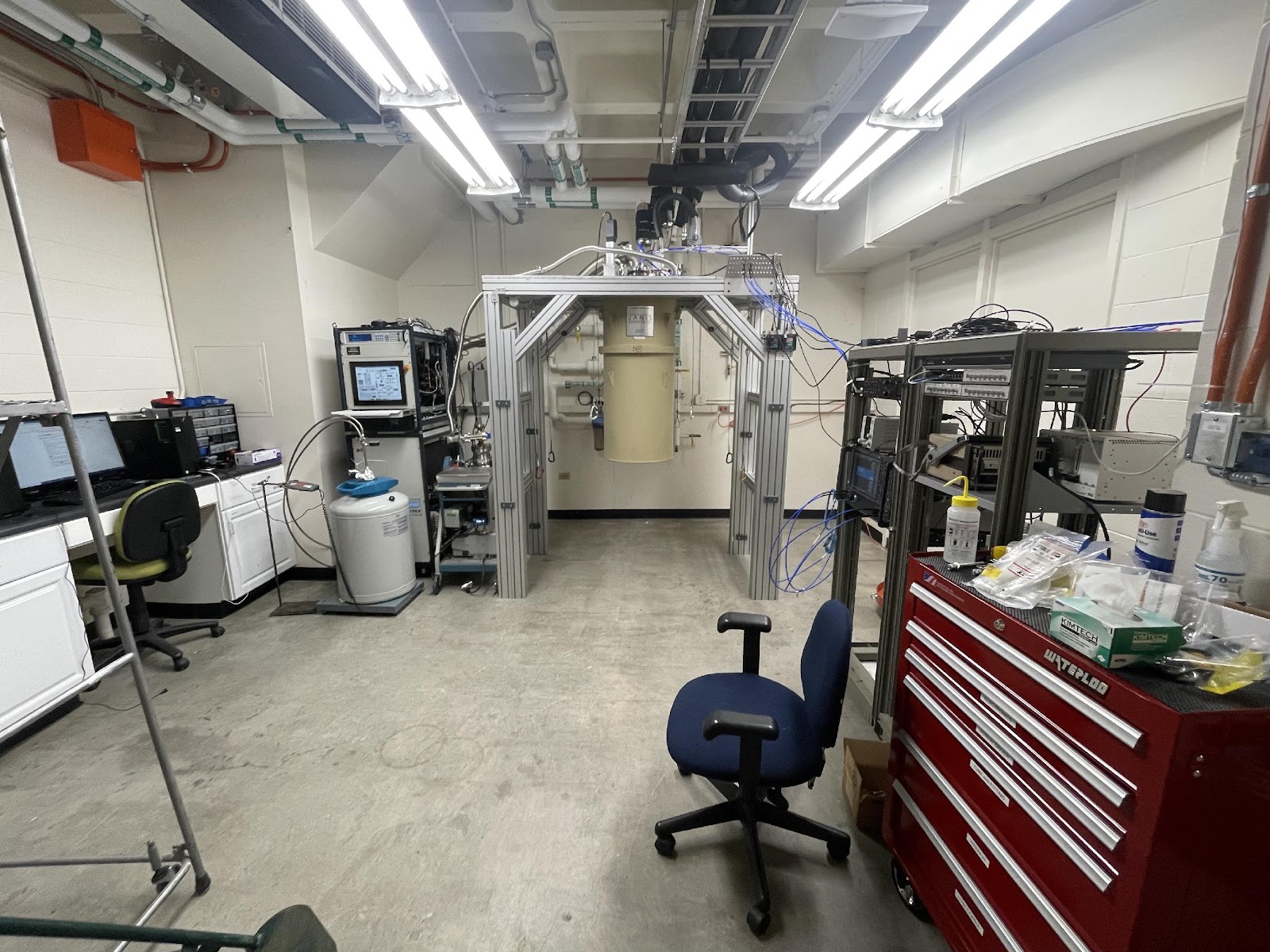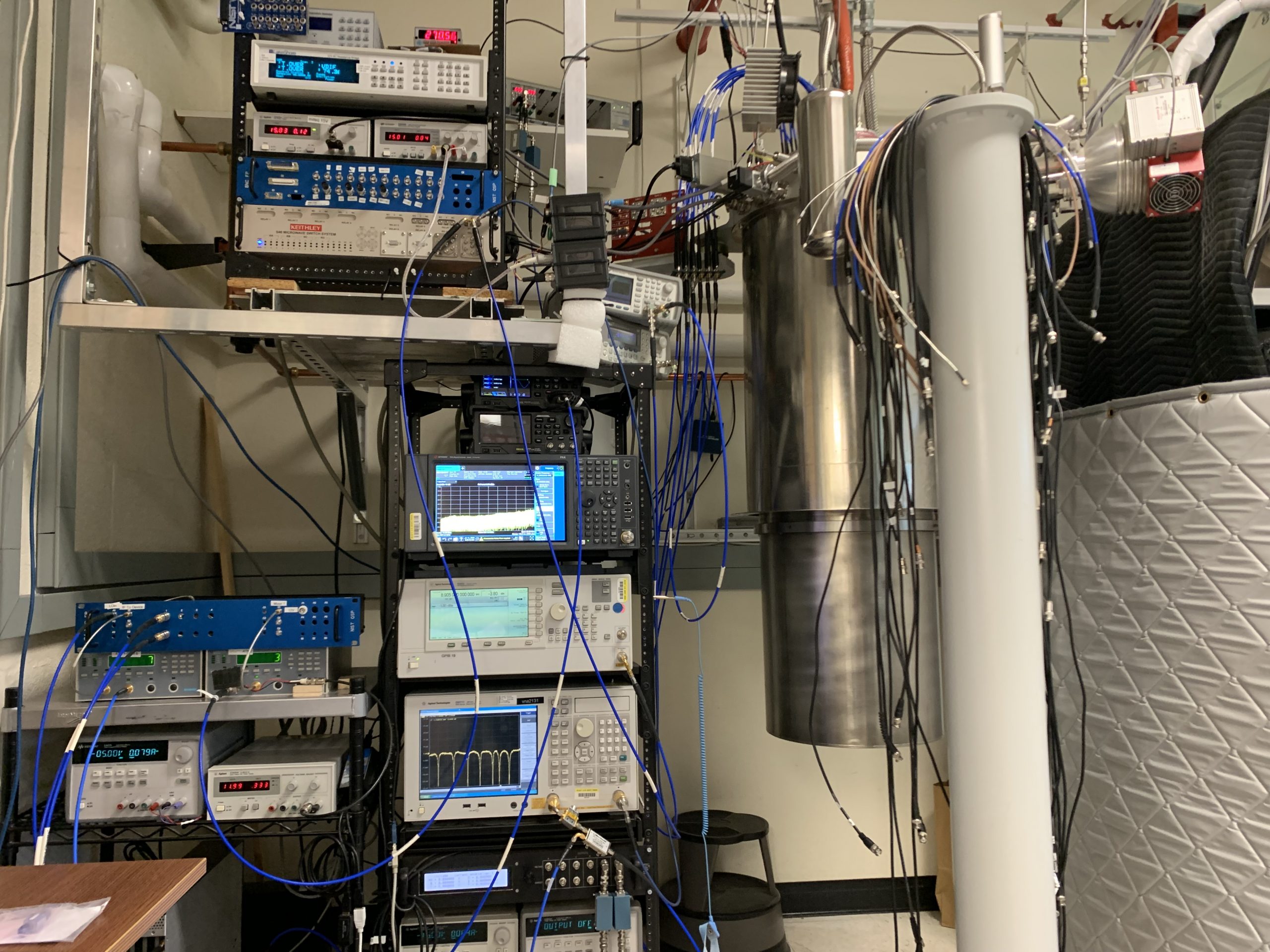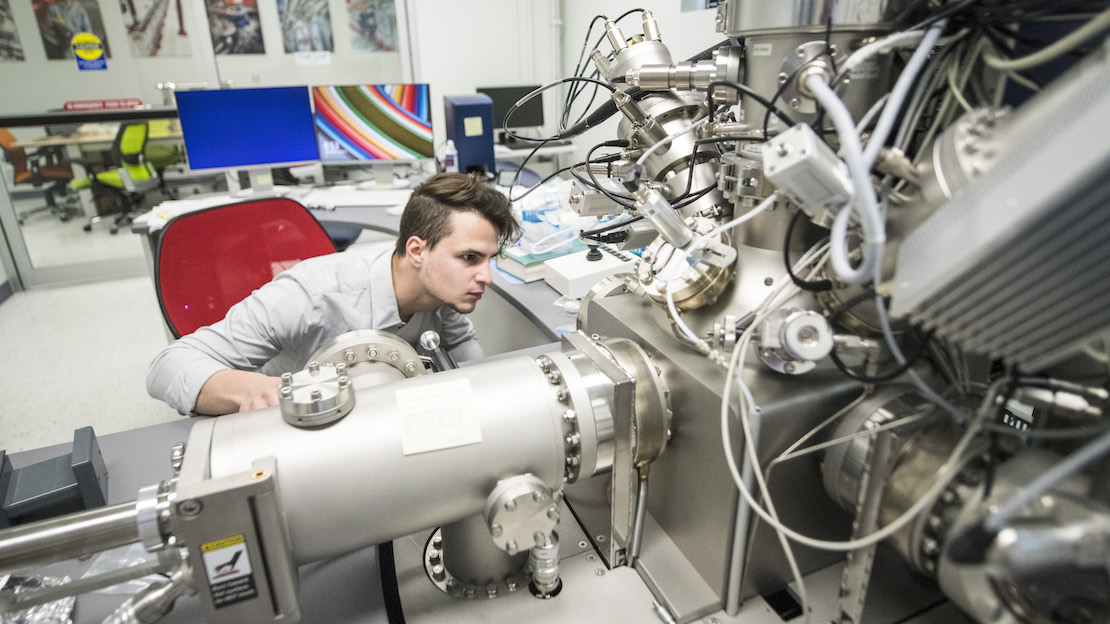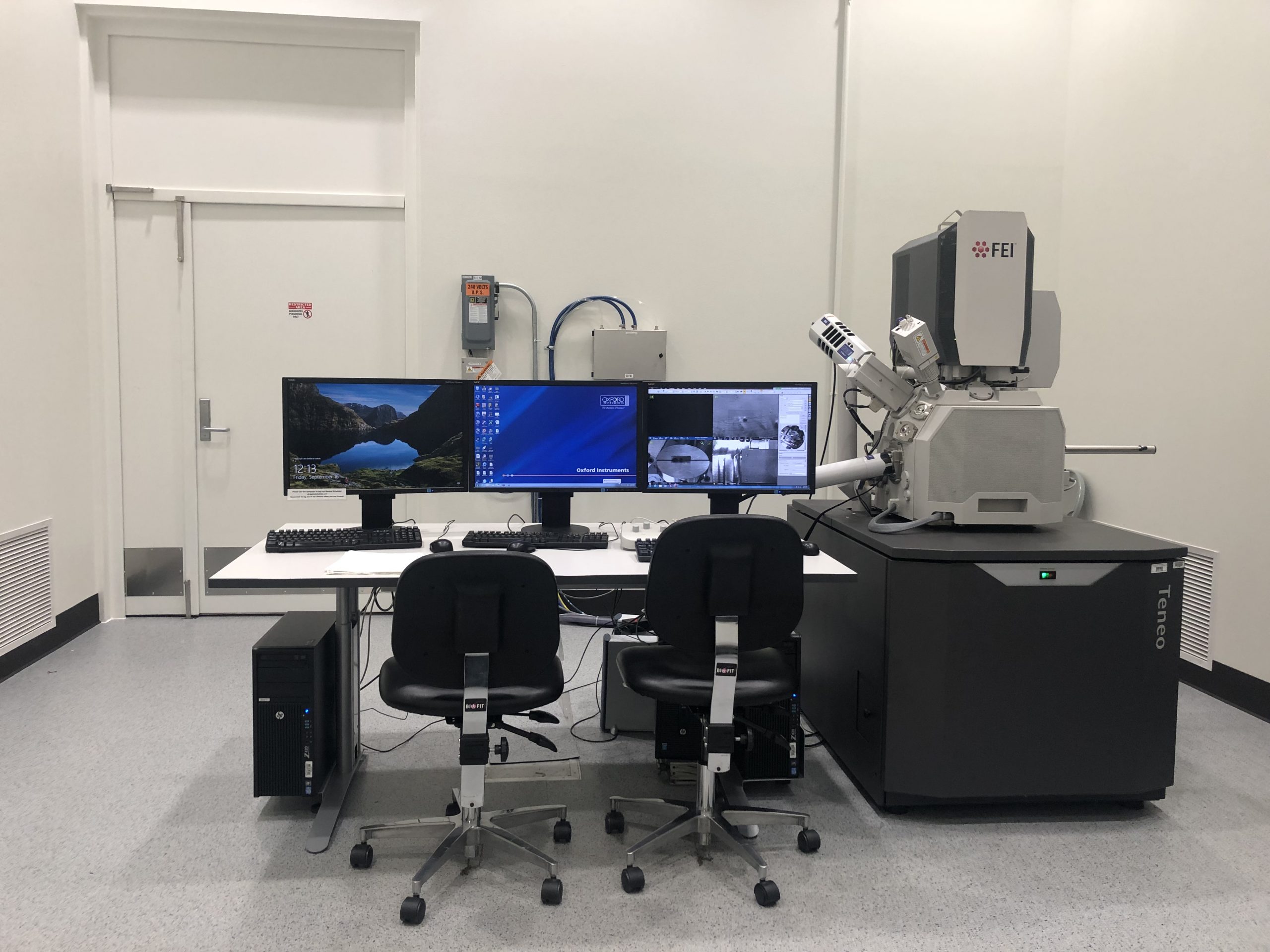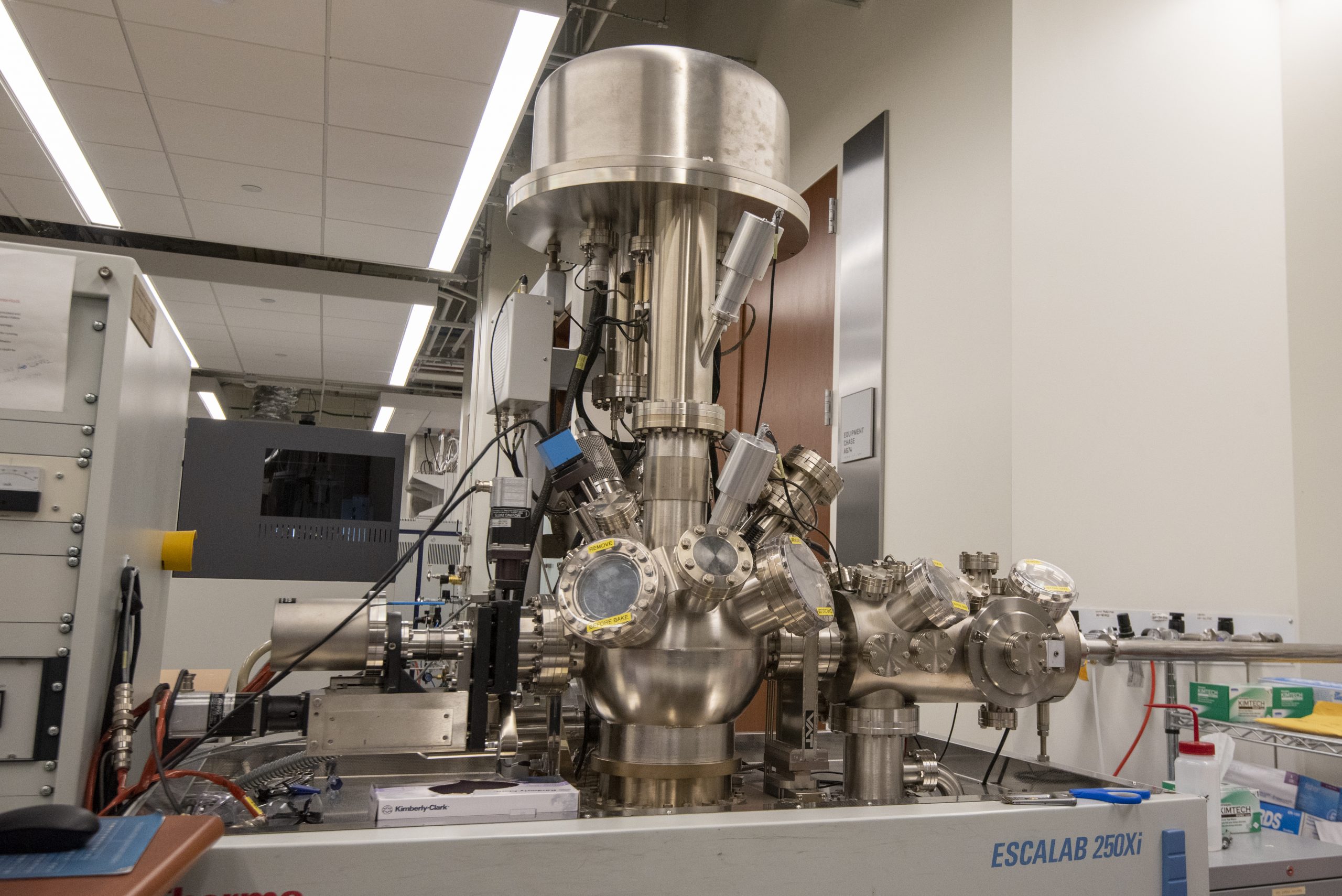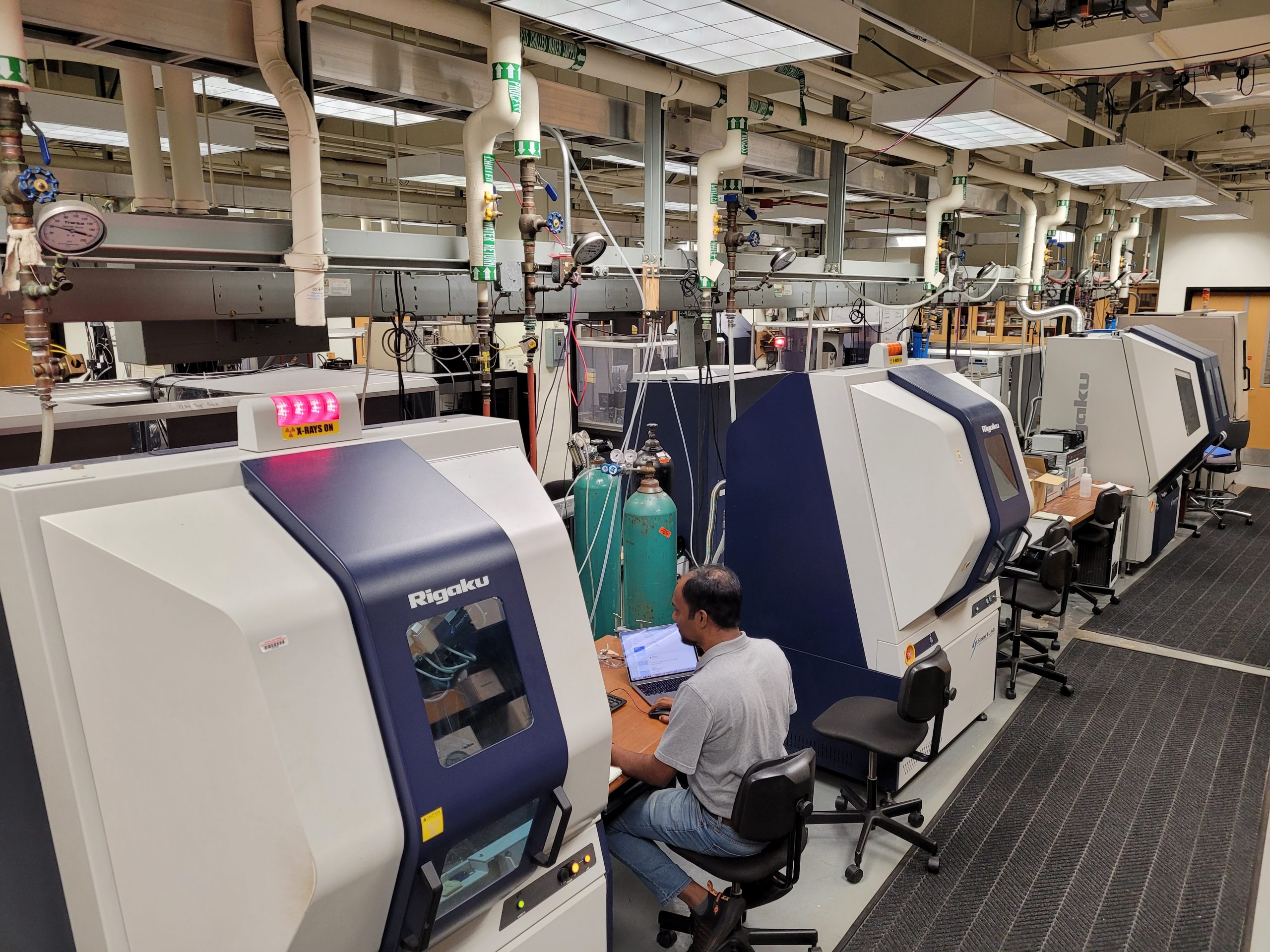Unique facilities and capabilities
A variety of new facilities have been constructed at the SQMS Center and the Center’s partner institutions. These state-of-the-art research centers are equipped with today’s most sophisticated technology, including quantum testbeds, qubit foundries, materials characterization tools and more.
Learn more about the SQMS flagship facilities, as well as the facilities each partner brings to the Center to achieve its ambitious goals and enable scientific discovery.
SQMS flagship facilities
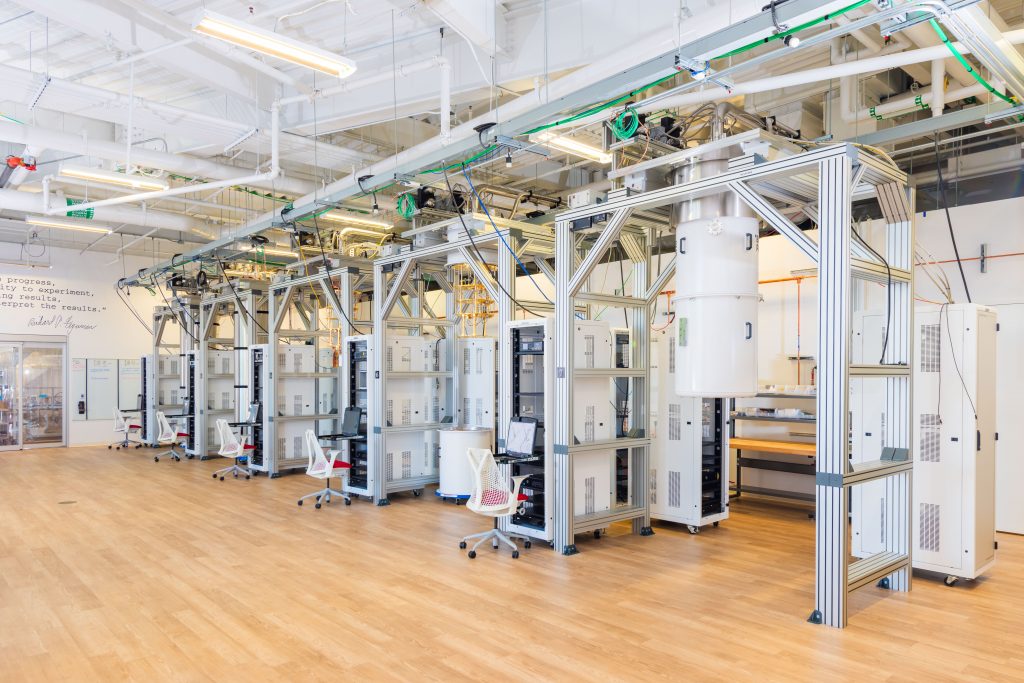
The Quantum Garage at the SQMS Center
The newest SQMS Center flagship facility is one of the largest quantum research laboratories in the country. The former garage space was re-imagined, designed and built by the SQMS collaboration. The 6,000 sq ft lab space is home to six new extra-large dilution refrigerators and devices capable of generating millikelvin temperatures and extremely high and low magnetic field environments. The fridges host platforms developed by the SQMS collaboration for quantum computing, sensing, metrology and communications.
Fermilab Quantum Computing Lab One (QCL-1)
QCL-1 was developed under the leadership of PI Alexander Romanenko. Two state-of-the-art, extra-large dilution fridges serve as quantum testbeds with multi-qubit control capabilities for quantum computing, sensing, and communication. Each dilution refrigerator can hold multiple SRF cavities and qubit chips. The large refrigerators have the capacity for meter-long cavities with many cells for multimode operation. One fridge is designed to sustain larger heat loads at the two-kelvin stage for special quantum-sensing physics experiments, such as searches for dark matter.
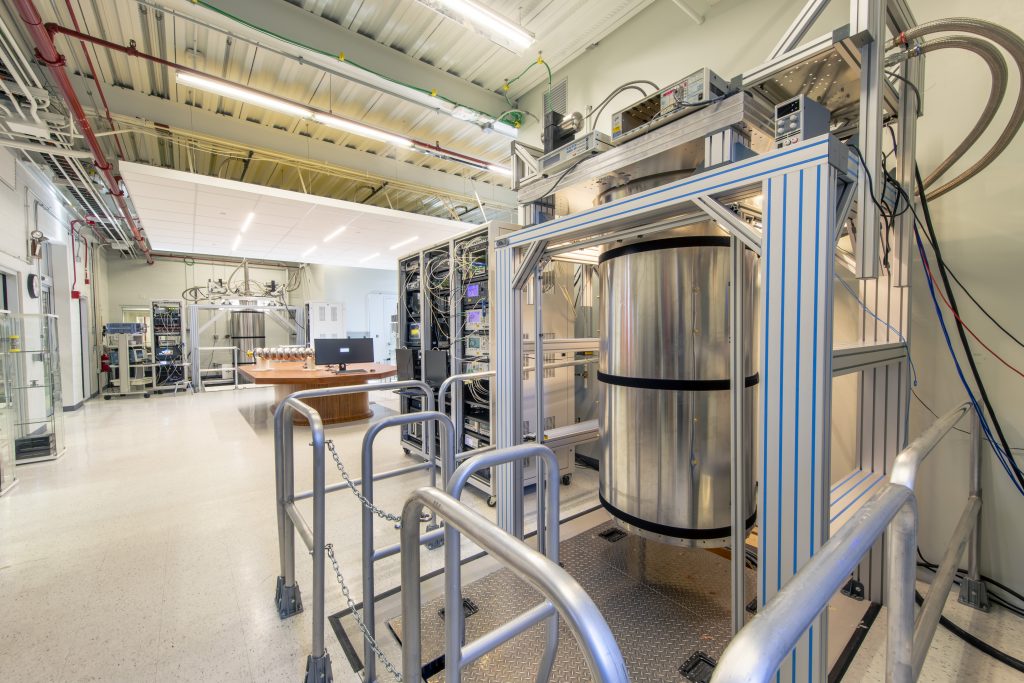
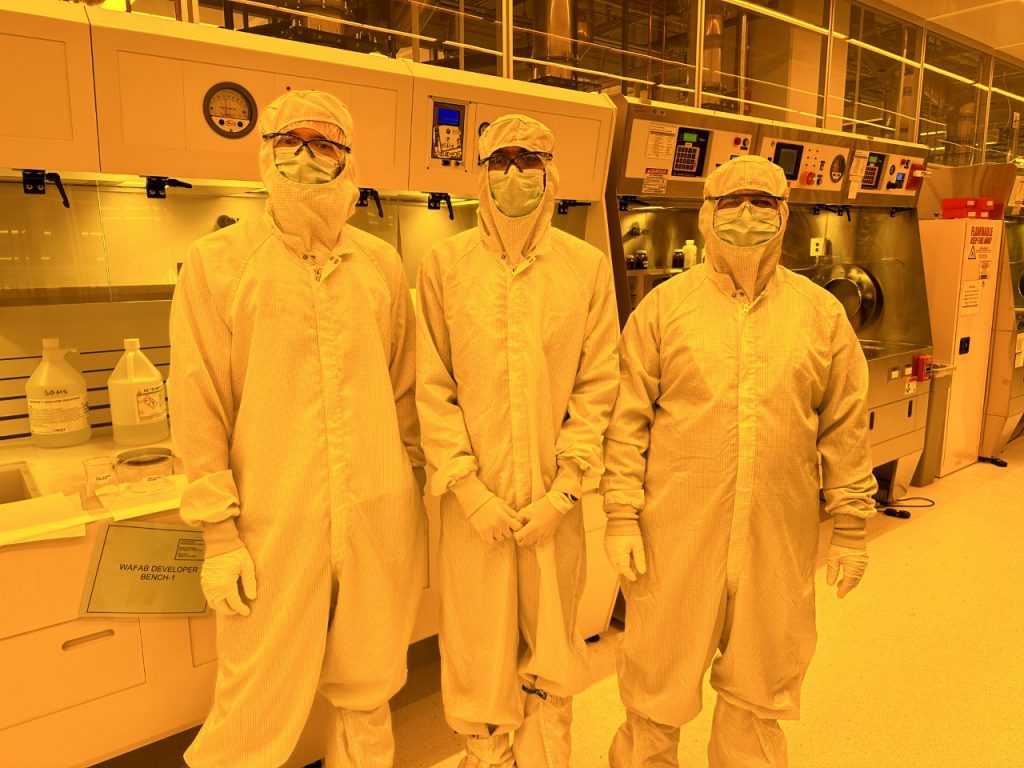
Fermilab Quantum Computing Lab Two (QCL-2)
QCL-2 is Fermilab’s first high-flexibility nanofabrication facility to advance cutting-edge research in high-quality films and materials for next-generation superconducting qubits. Here, researchers will focus on superconducting films and quantum devices with capabilities beyond current state-of-the-art facilities. QCL-2 will offer high-quality film deposition tools, double-angle evaporation tools, imaging and characterization tools, wet-processing benches, and post-processing and packaging tools.
Colossus
Colossus will be the world’s largest cooling dilution refrigerator. Housed within the Heavy Assembly Building on Fermilab’s campus, Colossus will contain hundreds to thousands of cavities with varying geometries and will have a cold volume of five cubic meters. This volume is significantly larger than the dilution refrigerators that are currently used for research and development and will have 10 times the cooling capacity. The tank for the dilution refrigerator has tested components at four kelvin and is now being upgraded to hold components at 10 millikelvin. The platform will connect to an existing 4K cryoplant and demonstrate the dry-wet technology, critical to enable scale-up to large quantum computing data centers.
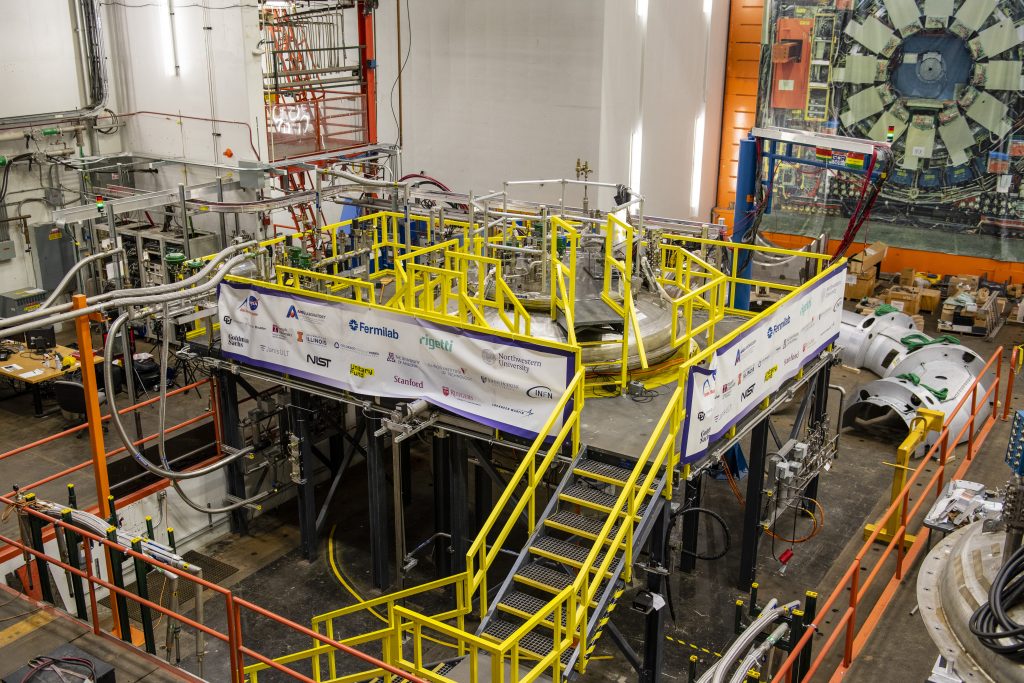
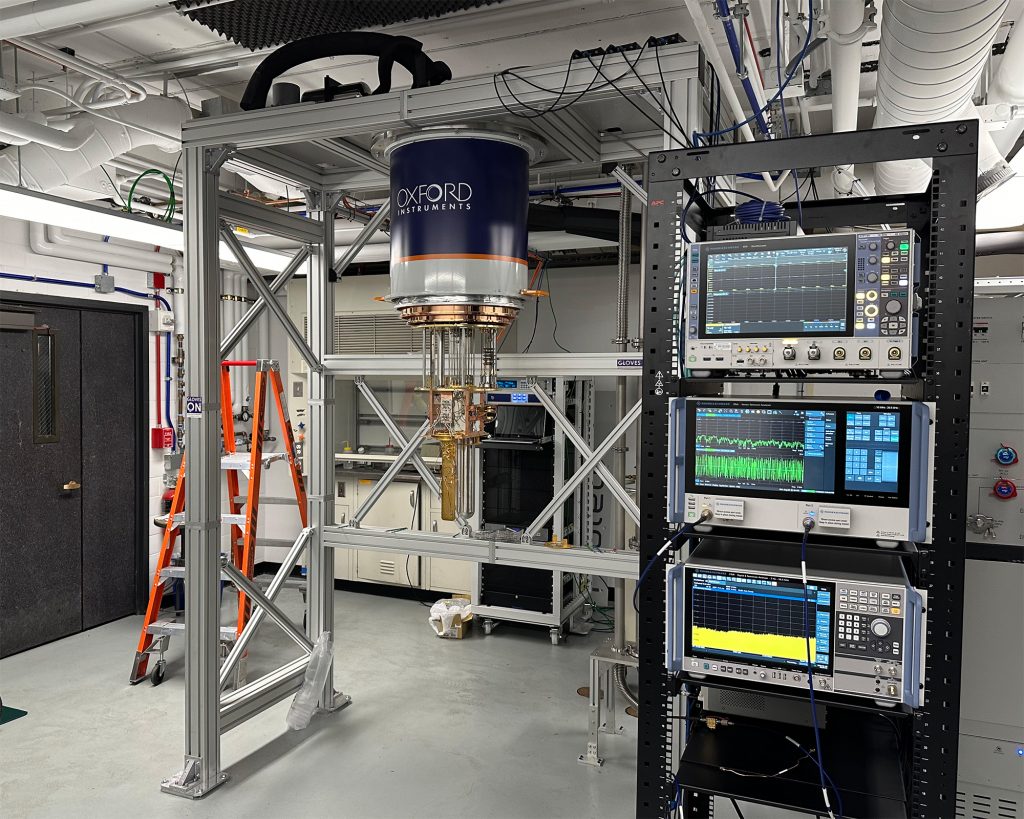
Northwestern QSET Lab
SQMS has commissioned a new quantum computing and sensing testbed at Northwestern University, which will advance research in superconducting qubits and train the next generation of the quantum workforce. Experiments at the Quantum Science, Engineering and Technology (QSET) laboratory aim to pinpoint and overcome performance bottlenecks of quantum devices, such a superconducting qubits, and provide hands-on training to students in superconducting quantum device measurements.
Cavities and qubits
SQMS is developing hundreds of custom-designed, high-coherence cavities, qubits and quantum devices with special geometries, tunable frequencies and various materials to enable experiments into unexplored QIS frontiers.
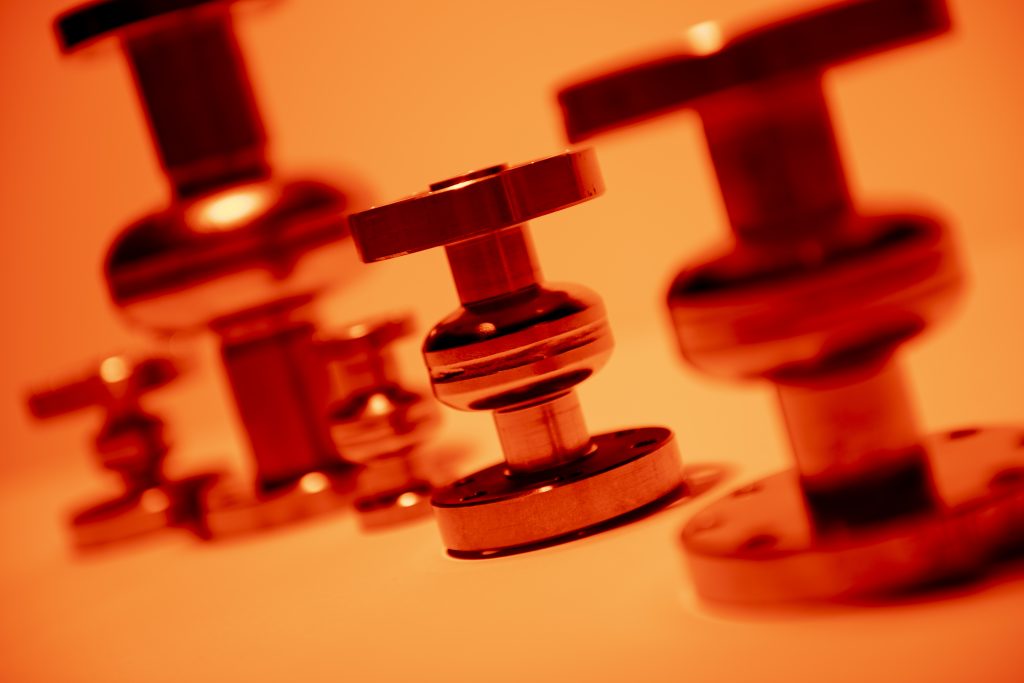
Quantum foundries
Millikelvin testbeds
Materials analysis laboratories
Institutions
- Sensitive Instrument Facility
Ames National Laboratory’s superconducting quantum materials characterization facilities will be primarily located in its Sensitive Instruments Facility. This building houses state-of-the-art electron beam microanalysis instruments and several unique systems for quantum sensing, including 2,800 square feet of low-acoustic, electromagnetic and vibration environment in six separate rooms. The facility also features two fully equipped laboratories with hoods (1,100 square feet), 1,200 square feet of office space and a conference room capable of hosting remote meetings. Ames will make available space in this facility and on the main campus for visiting scientists, postdoctoral scholars, graduate students and interns from the other partner intuitions to carry out collaborative research.
- Computing resources
Mines faculty members have access to research computing support and networked servers and printers. Mines maintains a shared computing cluster, for which faculty members may purchase nodes. Project collaborators currently own five nodes in the Wendian computer cluster and intend to purchase another three for use in this project (at least 36 cores/192GB RAM per node). High-performance computing (HPC) at Mines houses rack-mounted HPC clusters and blades composed of energy-efficient servers with Infiniband-connected Intel Xeon 16-Core 3.2 gigahertz processors, including advanced HPC software for node parallelization.
- Fermilab Quantum Computing Laboratory One (QCL-1)
QCL-1 houses two extra-large-capacity Bluefors XLD (extra-large dilution) refrigerators, each capable of providing test environments for superconducting materials and systems down to base temperatures of approximately 10 millikelvin with magnetic shielding to small background fields smaller than five milligrams. The QCL facility also includes state-of-the-art RF electronics systems for controlling and measuring muti-qubit and superconducting cavity-qubit systems. Learn more about QCL-1. - Fermilab material science laboratory
Fermilab’s material science laboratory has been developed for guiding innovation in SRF cavities performance, driving it from a fundamental understanding of the nanostructure and superconducting properties of the materials used. The lab offers a state-of-the-art TOF-SIMS with in situ heat treatment chamber and cryo insert, FIB-SEM with cryo insert, a PPMS and two Attocube setups for AFM and MFM measurements, SEM with EBSD and two laser confocal microscopes with cryo capabilities. All of these tools are now being used to pioneer analysis of superconducting qubit fragments and guide the development of new nanofabrication processes. - Colossus
Learn about Colossus. - Fermilab Quantum Computing Laboratory Three (QCL-3)
Learn about QCL-3. - SRF chemical processing facilities
For several decades, the SRF research community has been developing and improving procedures for processing niobium surfaces with complex geometries. Electropolishing (EP) with a concentrated mixture of hydrofluoric and sulfuric acid has become the dominant technique for providing extremely smooth surfaces with high performance. Fermilab’s advanced EP facilities are compatible with the high-frequency cavities typically used in QIS applications. - SRF heat-treatment facilities
SRF cavities for accelerator applications are typically heated at temperatures ranging from 120 to 900 Celsius. Fermilab’s heat treatment facilities include high-temperature, high-vacuum furnaces for degassing hydrogen from cavities and implanting nitrogen. The low-temperature heat treatment facilities were recently reconfigured to heat treat cavities at temperatures in the 300 to 400 Celsius range. This treatment is crucial for breaking up oxide and dissolving it into the niobium surface to remove it and substantially reduce TLS losses. This treatment was shown to increase quality factors in cavities at low temperatures and low fields from the 109 range to the 1010 range. - SRF cavity-coating facilities
Niobium has become an extremely high-performing SRF material after decades of development, but there are other promising SRF materials in the early stages of development that could offer potential performance improvements, even compared to niobium. Fermilab has two current early-career award recipients performing research on niobium-tin, and Fermilab’s coating facilities produce world-leading niobium-tin cavities. A new furnace to be delivered in 2023 will be capable of performing atomic layer deposition (ALD) and chemical vapor deposition (CVD) for novel materials and layered structures. - SRF cleanroom facilities
To protect the RF surface from contamination, SRF cavities are rigorously cleaned. Fermilab’s facilities include large ultrasonic cleaners, high-pressure rinsing stations, and ultra-pure water production equipment. This equipment is staged in semiconductor-grade cleanrooms. Assembling the cavities in this environment supports both cleanliness and reproducibility to minimize process variation. - SRF vertical cryogenic test facilities
Fermilab’s world-class vertical test facility hosts three large-capacity cryostats, each of which has a capacity of thousands of liters of liquid helium supplied by a refrigerator with a makeup rate of approximately 300 liters per hour of liquid helium. The cryostats can each hold up to four cavities at a time and have a high degree of flexibility so that they can be reconfigured for novel prototype experiments, such as dark photon and axion searches. The facility includes significant infrastructure for both room-temperature and cryogenic instrumentation and diagnostics. - High field cryogenic test facilities
Fermilab’s facility for testing materials used in superconducting magnets includes several dewars with inserts for solenoid magnets. These inserts allow materials to be evaluated under multi-tesla fields at cryogenic temperatures. The dewars are flexible and can be reconfigured for novel experiments, such as testing SRF cavities to evaluate their quality factors under high magnetic field conditions. The dewars are large enough for cavities of relevant frequencies to be installed, from high frequencies down to as low as three to four gigahertz.
- Zasadinski Laboratory
Prof. John Zasadzinski has full control over three separate laboratory spaces totaling more than 1,300 square feet. These laboratories house a four-helium cryostat with full tunneling electronics that can be used for planar tunnel junctions on niobium samples, a closed-cycle cryostat for R(T) and tunneling measurements, a UHV chamber for niobium foil annealing, two dual-source sputtering systems and one 500 vapor deposition system for thin film synthesis, and an FTIR spectrometer and UV/Vis spectrometer. Also, there are two additional Janis flow cryostats, one with an optical viewport, available. All science laboratories are housed in the newly renovated Pritzker Science building. Prof. Zasadzinski has ready access to a chemistry department instrumentation facility in Pritzker Science that includes a Renishaw Raman microscope. The IIT department of Mechanical and Materials Engineering has two full-time machinists and a well-equipped machine shop available for this project. There are two computational facilities, each with 12 PCs available to run theoretical computations in a parallel processing environment. - Physics department facilities
Other facilities that can be made available for this project include a pulsed laser deposition system, STM, a PHENOM SEM with EDAX and a Bruker x-ray diffractometer. The Physics department at IIT operates and manages two beamlines at the Advance Photon Source at ANL. Prof. Zasadzinski has access to the Materials Research Collaborative Access Team through Prof. Carlo Segre to perform x-ray scattering experiments including XAFS.
- Laboratorio Nazionale del Gran Sasso (LNGS)
The INFN – LNGS (L’Aquila, Italy) is the largest underground laboratory in the world. It hosts experiments in nuclear, subnuclear and astroparticle physics. Located about 120 kilometers from Rome, LNGS consists of three large experiment halls, each 100 meters long, 20 meters wide and 18 meters tall, and bypass tunnels for a total volume of approximately 180,000 cubic meters. Access to LNGS is horizontal, directly from the highway tunnel. With an average rock overburden of 1.4 kilometers, LNGS offers a reduction of the cosmic rays flux by six orders of magnitude. The neutron flux is also three orders of magnitude lower than on the surface due to the very low radioactive contaminations of the mountain rocks. As a support to the experiments, the underground site houses a radio-assay lab equipped with the best techniques for the detection of ultra-low levels of radioactivity. Above ground, an area of more than 23 acres hosts the surface site that comprises services and facilities like cleanrooms, mechanical and electronics workshops, chemical laboratories, computing center and cryogenics and vacuum services. About 1,100 scientists from 29 different countries participate in LNGS experimental activities. Currently six dilution refrigerators are present in the underground lab, among them the CUORE cryogenic system, the largest and most powerful dilution refrigerator ever built. Two additional dilution refrigerators will be installed in the near future. INFN will grant access to this unique facility to SQMS researchers and will offer the long-standing expertise of LNGS personnel in the construction and commissioning of cryogenic facilities in low-radioactivity and low-noise environments. Furthermore, it will offer the possibility of testing the most promising SQMS prototypes in one of the dilution refrigerators located in the underground laboratory, already in use for the operation of superconducting qubits. - Padova/Laboratori Nazionali di Legnaro (LNL)
The axion dark matter search laboratory at the LNL hosts the first-ever quantum-limited ferromagnetic haloscope. This detector has provided the best limit on axion-to-electron coupling constant in the axion mass range 42.4-43.1 μeV. This result is supported by state-of-the-art technological facilities that will be made available to the Center. At LNL labs, large quantities of liquid helium are provided on demand by the Cryogenic Service, allowing also for superfluid helium cooling of optical crystals. Microwave cavities—both normal and superconducting—have been developed, tested and fabricated for a variety of different experiments. SC niobium-titanium films on cavities are sputtered using a 10-centimeter planar magnetron. - Galileo Galilei Institute (GGI)
Hosted in the setting of the former Department of Physics and Astronomy on the Arcetri hill near the house where Galileo spent the last period of his life and died in 1642, the GGI is the primary INFN facility for training and higher education. GGI was founded in 2005 and was the first European institute dedicated to organizing and hosting long-term workshops (mainly in theoretical physics of fundamental interactions), with a structure similar to that of the Kavli Institute of Theoretical Physics (KITP) in Santa Barbara. Over the years, the GGI has been running on average three long-term workshops, together with conferences and training or focus weeks. In addition, starting in 2013, The institute has organized four Ph.D. schools every year. GGI courses are officially part of the Ph.D. training program for the Italian universities that join the initiative. The GGI facilities include large and small conference rooms, seminar rooms, office space and discussion spaces. The GGI secretariat routinely arranges accommodations for visiting scientists and students and is able to help with travel arrangements. All these facilities will be made available to the Center for doctoral and postdoctoral schools and for extended workshops and conferences.
- The Institute for Superconducting Rf Science and Technology (SRF Institute)
The Institute for Superconducting RF Science and Technology (SRF Institute) at Jefferson Lab has considerable expertise for the design, development, and prototyping of new SRF concepts and systems and for the development of novel processes and materials for SRF applications. Several deposition systems are exploited for the development of superconducting films and structures: ECR (electron cyclotron resonance) and HiPIMS (high power impulse magnetron sputtering) dedicated Nb deposition systems for samples and SRF cavities, a UHV multi-technique deposition system, a Nb3Sn furnace. The ECR sample deposition system produces Nb films of the highest quality. It allows varying Nb ion energies and substrate temperature for deposition on various sample sizes up to 3 inches. The UHV multi-technique deposition system is dedicated to the development of alternate superconducting materials (NbTiN, Nb3Sn…) and multilayer structures based on superconductors and dielectrics. The system is equipped with 4 DC/RF magnetrons with a central sample rotating stage. Several custom built pulsers and a Huettinger TruPlasma 6000 pulser are available for the generation of HiPIMS and reactive HiPIMS plasmas.The SRF Institute also hosts a cryogenic test area specifically designed for testing SRF cavities of a large variety of shapes and frequencies under a wide range of thermal and RF conditions. It is a production facility equipped with eight vertical dewars, a dedicated control room and a well maintained closed-cycle helium cryogenic system (capable of 300 W at 2 K) that can sustain multiple tests per day. Over 5000 SRF tests have been performed using this facility. It includes various advanced instrumentation, temperature mapping, second sounds sensors, magnetic sensors developed to characterize RF losses in SRF cavities. A multiplexed 4-point probe DC setup for Tc/RRR measurements (32 samples) and 3rd harmonic magnetometry system are available for cryogenic characterization of superconducting materials. A Keyence VHX-7000, a LaB6 SEM (Tescan VEGA 3XMH) with EDAX EDS and EBSD systems and an atomic force microscope are available on site for material and surface analysis. Jefferson Lab has also access through collaborators to XRD/XRR, dynamic SIMS, XPS, dual FIB/SEM with EBSD, HRTEM/STEM/EELS, and additional AFM and stylus profilometers. Other processing and testing facilities include two chemistry labs with electropolishing and chemical polishing facilities, a centrifugal barrel polisher, a 4000 sq.ft. ISO 4 cleanroom with a closed circuit BCP cabinet and two high pressure water rinsing tools, a RF structures lab with optical inspection bench, a cryomodule assembly area.
- Pleiades
Pleiades is a petaflop-scale supercomputer. It’s ranked among the most powerful systems in the world and is one of the world’s most powerful supercomputers. This distributed-memory SGI ICE cluster is connected with InfiniBand in a dual-plane hypercube technology. It is a 11,207-node SGI/HPE ICE supercluster with 241,324 cores, a theoretical peak of 7.09 petaflops and 5.95 petaflops sustained performance, and a 927 terabyte memory. - Electra
Electra is NASA’s first prototype modular supercomputing system. Electra is housed in environmentally friendly modules at NASA Ames Research Center. It is a 3,456-node SGI/HPE ICE X/HPE E-Cell system with 124,416 cores, an 8.32 petaflops theoretical peak with 5.44 petaflops sustained performance and 589 terabyte memory.
- NIST Boulder Microfabrication Facilities
The Boulder Microfabrication Facility (BMF) is a 1,700 square-meter (18,000 square-foot), ISO class 5 (class 100) cleanroom dedicated to providing state-of-the-art micro- and nano-fabrication capabilities to meet the microelectronic and microelectromechanical systems needs of NIST-Boulder staff members and their direct collaborators.
The Northwestern University Materials Research Center maintains a number of shared facilities that provide SQMS researchers access to state-of-the-art equipment. These facilities generally have on-site managers who are available to train users and provide technical support when using the equipment. Some of these facilities include:
- Northwestern University Atomic and Nanoscale Characterization Experimental Center (NUANCE)
NUANCE facilities contain extensive advanced microscopy and materials characterization instrumentation. For over a decade, NUANCE has assisted award-winning collaborative, interdisciplinary world-class nanoscale research. NUANCE provides and continually updates state-of-the-art and core analytical characterization instrumentation resources with 24/7 open access for the NU community and beyond. This includes hands-on training, education, research collaboration and outreach. The NUANCE Center houses five complementary instrumentation facilities for electron microscopy (EPIC and BioCryo), surface science analysis (Keck-II), scanning probe microscopy (SPID) and micro/nanofabrication (NUFAB). These facilities are available 24 hours a day, 7 days a week.- EPIC Facility offers a wide range of electron microscopy (both transmission and scanning), accessory instrumentation, and expertise to the scientific and engineering community through education, collaboration and service. The laboratory provides facilities for the preparation and examination of many types of bulk and thin specimens (foils/films) and fine particles and replicas, including biological materials, by transmission and scanning electron microscopy.
- BioCryo Facility provides a comprehensive source for characterization of biological, soft matter and hybrid samples with TEM (transmission electron microscopy), SEM (scanning electron microscopy) and STEM (scanning transmission electron microscopy) at cryogenic or ambient temperatures. This facility provides expertise and equipment for cryofixation and processing of frozen hydrated samples by high-pressure freezing, plunge freezing, cryo fracturing, cryo ultramicrotomy, freeze substitution and turbo freeze-drying. Conventional samples can be processed at ambient temperature with chemical fixation, dehydration and resin embedding, or critical point drying.
- The Keck-II Center facilitates research, collaboration, education and outreach in all science from soft biological matter to hard physical matter, specializing in surface analysis and nano-scale characterization.
- SPID was created to drive interdisciplinary research bridging the gap between hard nano structures, soft materials, biological sciences, quantitative mechanical and electrical analysis, and nano patterning. SPID provides a wide range of imaging instrumentation and support facilities for atomic to molecular imaging.
- NUFAB has cleanroom facilities that contain state-of-the-art equipment for characterization, deposition, etching-ashing, photolithography and wet processing in newly-built 6,000 square-foot class 100 and class 1,000 cleanrooms. It provides nanofabrication equipment and technical expertise to Northwestern, as well as other academic and industrial researcher
- NU Center for Atom Probe Tomography (NUCAPT)
Atom probe tomography (APT) produces a three-dimensional (3-D) atom-by-atom image of a sample, with sub-nanometer spatial resolution and a typically 150 x 150 x 500 cubic-nanometer analyzed volume, by simultaneous high-resolution imaging and time-of-flight mass spectrometry. APT is particularly suited to study nano- or nanostructured materials. The same samples can also be characterized by TEM in a correlative study. To compare these experimental results with atomistic simulations on the same size scale, ab-initio calculations and Monte-Carlo simulations can be performed at our facility. NUCAPT operates a CAMECA LEAP 5000XS tomograph. Specimen tips can be prepared by electropolishing (metals) and from almost any material by FIB (focused-ion beam milling). Ion beam sputter deposition creates thin film structures that aid with APT specimen preparation. Vacuum arc melting systems are available for synthesizing alloys and compounds. Thermocalc and MEDEA software packages are available for thermodynamic calculations and materials simulations. - JB Cohen X-ray Diffraction Facility
The JB Cohen X-ray Diffraction Facility has experimental setups for small-angle X-ray scattering (SAXS), X-ray fluorescence (XRF), high-resolution X-ray diffraction (HRXRD), X-ray reflectivity (XR), X-ray standing waves (XSW) and grazing incidence X-ray diffraction (GIXRD). - Northwestern cryogenic facilities
Cryogenic facilities at Northwestern serve the broad range of research groups that are contributing to this project requiring low temperatures and test beds for quantum devices. These include superconducting materials characterization, measurements of RF response, evaluation of surface processing of cavity materials and Josephson interference devices, magnetization, acoustic impedance, and STM and NMR magnets that require liquid helium. Ultra-low-temperature platforms where long quantum coherence times can be achieved have been developed and will be expanded for project applications. These range from transmon device development to dark matter detection. One of the unique facilities that can assess the surface electronic structure of niobium cavity materials uses the solid state NMR high field spectroscopy of nuclear relaxation times and local magnetic field measurements up to 600 megahertz. - Northwestern Quantum Science, Engineering and Technology (QSET) Lab
Learn about the QSET Lab. - Integrated Molecular Structure Education and Research Center (IMSERC)
The IMSERC facility performs a full range of chemical analyses for students and research groups at Northwestern University and the greater Chicago area. Such analyses include qualitative composition determination, quantitative analysis and molecular structure determination. The most commonly used techniques are NMR spectroscopy, mass spectrometry, optical spectroscopy, trace metals analysis and single crystal X-ray crystallography. As a “one stop shop” for molecular structure characterization, all instrumentation and staff scientist offices are located in a single location. - Laboratory for Atomic and Photonic Technologies (LAPT)
The facilities of the LAPT, directed by Prof. Shahriar, will be made available for some of the work for the dark matter detection experiment, including the development, testing and optimization of a pair of subluminal lasers. This laboratory is a state-of-the-art facility for carrying out experiments involving atom-laser interactions. LAPT has a wide range of technical infrastructure, including several rubidium atomic beams, rubidium and sodium vapor cells, and three magneto optic traps (MOTS). It has four Ti-Sapphire lasers, each pumped by a separate ion laser, six tapered amplifiers and many tunable diode lasers, which could be tuned to the D1 or D2 line of rubidium. It also has five large, floated optical tables and a host of optical, mechanical, microwave and vacuum components of direct relevance to the work to be done for this project. - Quest HPC cluster
Quest is housed at one of the university’s secure data center facilities and offers a large, shared computational facility. Quest is used for a variety of projects, including those that require high-performance capability due to computationally intensive tasks, such as intense numerical calculations or dealing with extremely large datasets. Computing services available from Quest include parallel filesystem: IBM GPFS, IBM ESS storage system with Infiniband connections, compute access over 11,800 CPU cores in a mixture of Intel Ivy Bridge, Haswell and Xeon processors, and a wide selection of analytical software. Quest comprises four login nodes that users connect to directly and 679 compute nodes with a total of 16,028 cores used for scheduled jobs. Both the login and compute nodes run the Red Hat Enterprise Linux 6 operating system. Quest has an IBM GPFS parallel file system with ESS storage totaling approximately 3.5 petabytes. Users have access to a small (80 gigabyte) home directory, as well as a project directory with storage optimized for I/O operations. Basic access is centrally provided at no cost to approved Quest users. - Research Data Central Storage Service
The University’s Research Data Storage Service is the university’s central platform for research information, provides alternative storage platforms for storing computational data, and enables investigators to share research data in a collaborative environment, store large-scale computational research data and request additional storage for further data analysis. Research Data Storage Service provides campus researchers the ability to subscribe to a minimum of one Terabyte of desktop mountable storage for research purposes. This service provides a platform to store research data. This storage should be used when storing files larger than 15 gigabytes or when using regulated data, such as PHI, PII, etc. Northwestern University Information Technology (NUIT) research computing staff provides consultation on new applications and technologies related to HPC and research computing. NUIT also offers regular workshops and training sessions on the use of Quest, data storage services and other computing resources. - Innovation and New Ventures Office (INVO)
INVO manages Northwestern University’s invention disclosure, assessment, patenting and marketing processes. INVO actively scouts for research with commercial potential, offers guidance on development, and coaches inventors through the process of intellectual property rights. Commercialization resources include: Chicago accelerators and incubators (1871, MATTER and mHub) that provide University affiliates and startups access to the energized atmosphere of inspiration, information and innovation; commercialization clinics and seminars; entrepreneurs-in-residence; The Garage, a hub for student entrepreneurship and innovation; INVOForward, which accelerates commercialization by supporting entrepreneurs in the customer discovery process; INVOHub – Stage Zero Resources, a Northwestern incubator program to increase Northwestern’s pipeline of research-based startups; INVOReach which develops resources to improve the diversity of inventorship and entrepreneurship at Northwestern; NUSeed, Northwestern’s $4 million pre-seed/seed investment fund; NUVention, a course designed to expose students to the entire innovation and entrepreneurial lifecycle; N.XT, Northwestern’s $10 million fund designed to foster and support early stage innovations; The Practicum, an unpaid internship program open to all Northwestern students and postdoctoral fellows who are interested in learning more about the technology transfer process and being exposed to the vast areas of innovation at Northwestern; and SBIR/STTR consultation to assist teams in developing proposals for Small Business Innovation Research (SBIR) and Small Business Technology Transfer (STTR) grants to commercialize Northwestern technologies.
- Rigetti Fab-1
Located in Fremont, CA, Rigetti has established the world’s only dedicated quantum integrated circuit (QuIC) foundry, capable of producing high-quality multi-qubit devices with state-of-the-art coherence times on relatively short lead times. This facility is centered around an end-to-end manufacturing capability for high-performance superconducting qubits, with distinguishing capabilities for coherence and for three-dimensional, heterogeneous integration for advanced signaling and scalable architectures. A Blufors refrigerator is co-located on site for rapid-turn cryo-testing of test devices and production-ready QPUs (quantum processing units), allowing for shorter fabrication and iteration loops. Rigetti completed an expansion of this facility in the first half of 2020, increasing total cleanroom size to 6,000 square feet. This allows further capacity for additional fridges and co-location desks for visiting SQMS researchers, students and interns. - Rigetti quantum computing facility
Rigetti’s quantum computing facility, co-located with its headquarters in Berkeley, CA, contains eight Blufors dilution refrigerators. These dilution refrigerators currently house the majority of Rigetti’s test and development QPUs, as well as several production chips, including those currently available on Rigetti’s Quantum Cloud Service (QCS) and AWS Braket. The facility serves as a test environment for superconducting QPUs operating under environmental monitoring and control (e.g., diesel backup generators) with associated physics and engineering teams, plus the requisite experimental hardware. Each dilution refrigerator can hold multiple QPU towers to allow several different experiments to be performed in a single cooldown.
- Strontium clock interferometry lab (Hogan)
The Hogan clock interferometry lab has two independent strontium atom sources for atom interferometry experiments. The lab has 770 square feet of space, is two floors tall and includes high-bay space that will be used for a 10-meter tall atom interferometer gradiometer. The lab has mezzanine work platforms that provide access to the apparatus at intermediate heights. The existing strontium atoms’ sources have already been employed to demonstrate state-of-the-art large-momentum-transfer atom interferometry based on single-photon transitions. This atom source hardware will be used to experimentally implement the proposed optimal control procedures for efficient momentum transfer and to test multipass imaging protocols. - 10-meter atom fountain lab and spin squeezing lab (Kasevich)
The Kasevich 10-meter fountain lab has an operational 10 meter-scale rubidium atom interferometer. This specialized lab space includes a 25-foot-deep, 8-foot-diameter pit that houses the long-baseline atom interferometer. The lab also includes a high-power CW laser system at 780 nanometers designed to drive two-photon Braggs with high efficiency for next-generation large momentum transfer atom interferometry. This atom interferometer can be used to experimentally implement the proposed optimal control procedures for efficient momentum transfer in rubidium using single- and dual-species operation modes. The Kasevich spin squeezing lab has demonstrated 20 decibels of metrologically relevant squeezing in an ensemble of rubidium atoms. This lab will be used to test the optimal quantum control protocols on entangled atoms, aiming to reduce loss associated with imperfect pulse efficiency in large momentum transfer application.
- New Science and Education Research Center
The laboratories of the PI (Maria Iavarone) and the Physics department recently moved into the new Science and Education Research Center. The 247,000-square-foot building is one of the largest buildings devoted exclusively to scientific research in the Philadelphia region. The labs that the PI occupies are ultra-low vibration STM labs. The two UHV STM systems are placed on 40 tons of inertia block, separated from the main building and floating on air dampers. The UHV-STM is surrounded by an acoustic and RF-shielded room. All the control electronics are placed outside the room. The PI’s labs are located in the basement of the building. This building also hosts the Temple’s Materials Institute with shared computational and experimental facilities for collaborative interdisciplinary research. - Temple Materials Institute cleanroom
This facility has an 800-square-foot, class 100 area and a 1,200-square-foot, class 1,000 area. It houses equipment that includes resist spinner, mask aligner, ion mill, reactive ion etcher, magnetron sputtering and optical microscope, as well as space for assembling detectors for high-energy physics studies. - Machine shop in the College of Science and Technology (CST)
The Research and Instructional Support Facility (RISF) provides machining, electronics, glass blowing, technical design and consulting services to CST and Temple University researchers. A student machine shop located adjacent to the main facility allows students to use basic shop tools to support their work after taking a required shop introduction and safety program. The machine shop is equipped with capabilities that include milling, lathe turning, surface grinding of typical metals, including aluminum, brass, stainless steel and other metal alloys, wlding of metals like aluminum and stainless steel for both structural purposes and leak-tight vacuum or pressure vessels, soft or hard soldering of stainless steel, copper, brass and other cuprous metals, and machining of acrylics and other types of polymers. Custom-made or modified fabricated parts can be joined by either solvent welding or hot-air fusion for liquid- and air-tight seal.
- Prof. Zhang Lab
Dr. Zheshen Zhang joined the University of Arizona (UA) in fall 2017 as a faculty member in the Department of Materials Science and Engineering (MSE) and the College of Optical Sciences (OSC). Dr. Zhang operates approximately 650 square feet of lab space in the MSE building and shares about 500 square feet of lab space with other faculty members in the OSC building. Zhang also leads the NSF MRI INQUIRE development project, whose core facility is located in the basement of the Electrical and Computer Engineering (ECE) building with approximately 700 square feet of lab space. In addition, UA operates two nanofabrication core facilities located in the OSC building and the ECE building to provide electron beam lithography, etching, characterization and testing capabilities. - Prof. Zhuang Lab
Dr. Quntao Zhuang joined UA in 2019 as an assistant professor in the ECE and the OSC. The research group focuses on the theory of quantum information, including quantum computing, sensing and communication. As a theory group, Dr. Zhuang’s group has access to UA’s high-performance computing (HPC) facility, which provides a 512-core Itanium2 SGI Altix 4700 (Rpeak=3.3 TFLOPS) with 1024 gigabytes of memory, a Field- programmable gate array (FPGA) to run blast applications for a 15-20x speedup, and a Beowulf 32-node machine where each node is a dual AMD 2000+ processor with two gigabytes per node. The HPC staff have installed standard parallelized programs, such as Blast and Clustel. Additionally, they will install requested programs and work with researchers to parallelize applications. - Prof. Vasic Lab
Offices are provided to all faculty and researchers in the ECE building. Researchers have personal computers that are connected to the ECE computational resources and university supercomputer facility. - Research Data Center Xeon Phi/GPU cluster
In January 2012, the UA research computing program opened the new Research Data Center (RDC). Among the four systems available to UA researchers, the Extremely LarGe Advanced TechnOlogy (El Gato) cluster is particularly relevant to the SQMS project. El Gato is a CPU/GPU hybrid cluster jointly funded by UA and the National Science Foundation. El Gato uses specially designed hardware, including NVIDIA K20X GPUs and Intel Xeon Phi 5110p coprocessors, to economically achieve high performance levels. The system is designed around Intel Ivy Bridge CPUs, large amounts of memory per node (256 gigabytes per node) and FDR Infiniband. The system is also connected via FDR Infiniband speed to a DataDirect Networks SFA 12K petabyte-scale storage server. El Gato comprises 90 compute nodes, one login node and one administrative node. The nodes are connected via a Mellanox FDR Infiniband network with a fully non-blocking fat tree topology. Seventy nodes are configured with NVIDIA GPUs and 20 nodes are configured with Intel Xeon Phi coprocessors. - Research Data Center storage facility
The RDC is a state-of-the-art computer storage hub that triples the university’s previous capacity to host centralized large computer clusters. Scientific research, particularly the kind done at the university, relies upon HPC and high throughput computing (HTC) capacity to hold and analyze the multitude of data collected during research. These services are open to any faculty, researcher or student who has a use for HPC/HTC systems. Besides the El Gato system, there are four other systems (three computing and one storage) and each system provides different capabilities. Users can select the appropriate platform(s) to optimize their computational research projects. - Visualization environment
Visualization assists researchers in developing a deeper understanding of their data and provides new insights through human’s powerful visual system. Research Computing is home to the UA Laboratory for Immersive Visualization Environments (AZ-LIVE). AZ-LIVE is a space where university researchers, faculty and students are immersed in interactive, 3-D, stereo, computer-generated worlds. The combination of 3-D computer graphics, stereoscopic projection technology, acoustical tracking devices and four-channel audio creates the illusion of being present in a virtual world. The environment utilizes a multi-processor HPC workstation cluster capable of handling and displaying large datasets. The advanced projection and tracking system, along with the computing technology in AZ-L IVE, combine to create an environment in which a wide range of applications, models and virtual worlds can be displayed and navigated interactively. - ECE computing facilities
The following equipment is dedicated to research support: a) PCs: 51 Pentium 4 3.0 gigahertz with 1GB RAM. (can be configured for MPI) (ECE 226) 26 Pentium 4 2.6 gigahertz with 512 MB RAM. (CE 208), b) Workstations: 10 Sunblade 1500 (ECE 208), 14 SunRay terminals (ECE 204), c) Servers: 8 Sun Ultra 5 configured for mpi, SunFire V240, Sun Enterprise 220R (ECE 206c), SunFire V100 (ECE 206c), 2 Sun Netra X1 (ECE 206c), 1 SunFire V210, 1 Sun Ultra Enterprise E450, 2 Gateway 930 series, 2 Gateway 955 series, 3 Gateway 915 series, d) Storage: 1 NetApp FAS 250, 2 Sun Storage L8, Networking, 1 Catalyst 3560G Series, 1 3Com 4900 16 ports, 1 3Com 9000, 7 3Com 4400 24 port switches, 3Com 3300 24 port switches, e) Wireless: 11 Cisco AP1231G WAP. The ECE department has additional facilities for media creation and editing such as cameras, recorders, scanners, color printers and grayscale printers.
- Pritzker Nanofabrication Facility (PNF)
At present, SQMS scientists use the PNF at the University of Chicago to fabricate superconducting quantum devices. PNF is a 10,000 square-foot, class-100 cleanroom with state-of-the-art equipment for nano/micro fabrication. Available equipment includes physical and chemical deposition tools, such as sputtering and atomic layer deposition systems, wet and dry etching tools to allow chlorine- and fluorine-based etching, and optical and electron beam lithography systems for patterning with feature sizes down to 100 nanometers, as well as characterization and inspection tools, such as scanning electron microscopy and profilometry. PNF allows SQMS to explore materials and interfaces to realize qubits with better coherence time.
- Boulder Cryogenic Quantum Testbed
The Boulder Cryogenic Quantum Testbed at JILA, CU Boulder is a non-profit, pre-competitive research facility for developing and openly disseminating standard protocols to reproducibly measure the quality factor and performance characteristics of superconducting microwave resonators used in quantum computing circuits. The Boulder Cryogenic Quantum Testbed hosts an open source, collaborative codebase for the fitting and analysis of superconducting quantum devices. The lab contains a high-performance experimental setup for measuring superconducting microwave resonators at millikelvin temperatures and single photon powers.
- Center for Instrument Sharing of the University of Pisa (CISUP)
The CISUP is an interdepartmental laboratory platform offering access to a wide range of analytical instrumentation for life and physical science researchers. CISUP gathers 477 faculty members and technical staff from 18 departments supporting the CISUP mission of research, education and service at the national and international level. - Green Data Center
University of Pisa Green Data Center is a next-generation data center facility built in San Piero a Grado (Pisa), starting in late 2016. It’s built on the latest available technologies either on power supply and distribution or on cooling facilities, reaching a record PUE (power used effectiveness) of 1.15/1.2 medium/year. A 250-square-meter computing room hosts 66 racks equipped with two separate power supply circuits and in-row cooling facilities provided by Vertiv. Green Data Center hosts more than 700 latest-generation servers for a total of about 20k cores, more than 100Tb RAM, around 100GPU and 12 petabytes of storage dedicated to scientific computing (HPC clusters, GPU servers, multiprocessor nodes) and virtualization services (self-service virtual machine systems and virtual desktops). High-performance storage solutions are provided by Dell Technologies, DDN, Nvidia and Weka/IO.Networking is based on latest-generation 25/100 Gb/s Ethernet switching (provided by Arista Network) and Infiniband/Omnipath (provided by Mellanox and Cornellis Network) for HPC and storage services.Green Data Center is connected to the university network with a 200 Gb/s fiber network and to the GARR Network with a 20 Gb/s link. Security is provided by a zero trust architecture based on SonicWall next-generation firewall solution.Green Data Center hosts Dell Technologies and Intel Center of Excellence for HPC.
- The Quantum-Nano Fabrication and Characterization Facility
The Quantum-Nano Fabrication and Characterization Facility (QNFCF) at the University of Waterloo operates several nanofabrication labs. The main lab is an 8000 sq.ft. lab with ISO 4,5,6 process bays. This lab is equipped with various tools relevant for fabrication and characterization of superconducting devices including electron-beam lithography (30 keV and 100 keV), optical lithography (serial and parallel writing), a deposition tool dedicated to high quality aluminum films and Josephson junctions, various deposition tools, reactive ion etching, packaging (dicing, cleaning, bonding), and a range of inspection tools including electron and optical microscopy, profilometry, and atomic force microscopy.
- The Superconducting Quantum Devices lab (Lupascu group)
The Superconducting Quantum Devices (SQD lab) focuses on the low temperature characterization of superconducting devices, including various types of resonators and qubits. The laboratory is equipped with two dilution refrigerators, with base temperature of 12 and 20 mK respectively, and large experimental space. Qubit control equipment includes arbitrary waveform generators with moderate bandwidth (for pulse shape control) and high bandwidth (for direct digital synthesis control), microwave synthesizers, custom microwave circuits for control and readout, digitizers, various test equipment (vector network analyzer, high frequency digital oscilloscope, spectrum analyzer), and low noise low frequency electronics. One important area of specialization of the lab is control and noise characterization in flux type qubits.

